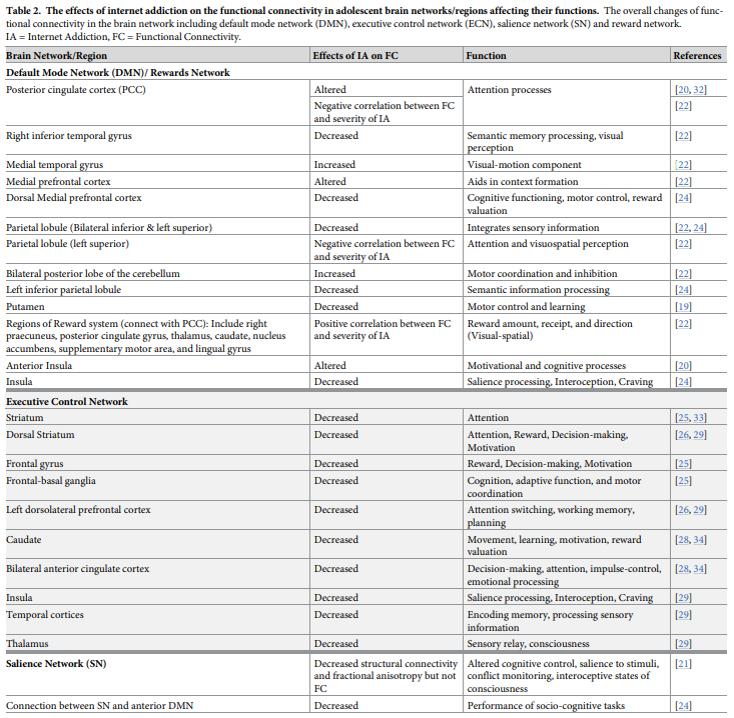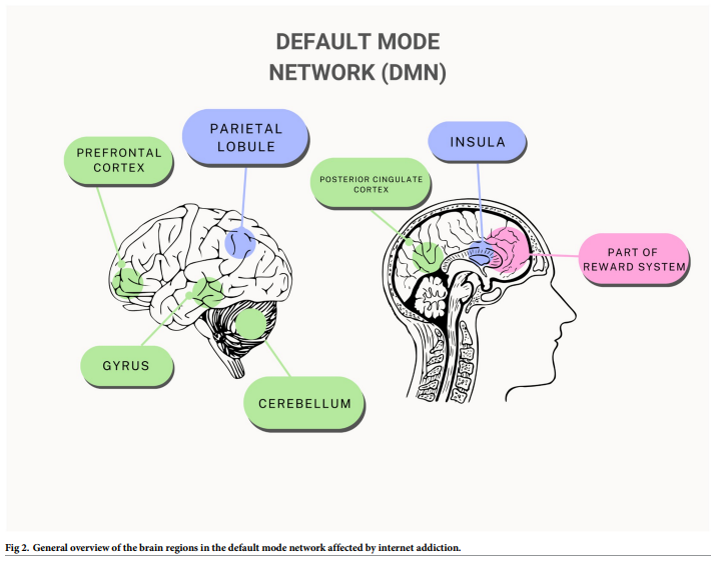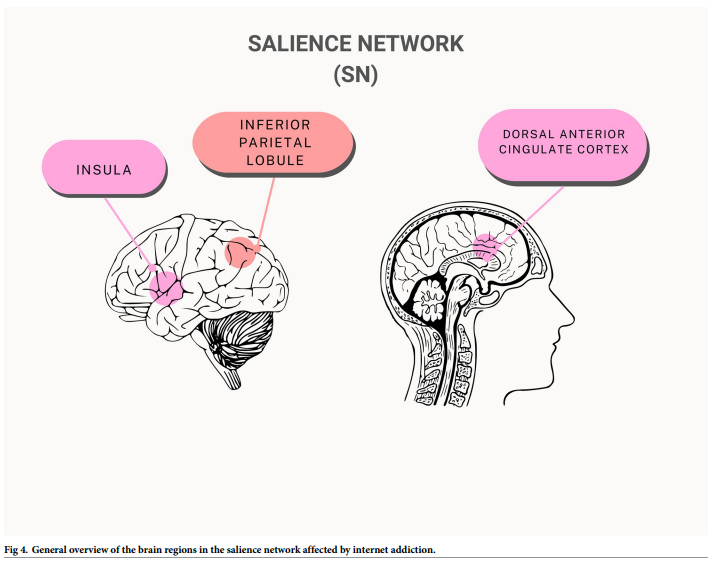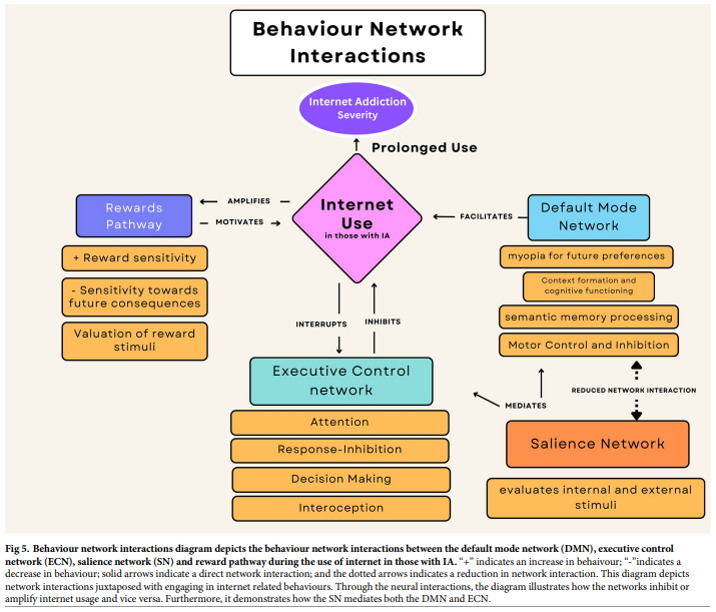5. Results
With the search performed on the selected databases, 238 articles in total were identified (see Fig 1). 15 duplicated articles were eliminated, and another 6 items were removed for various other reasons. Title and abstract screening eliminated 184 articles because they were not in English (number of article, n, = 7), did not include imaging components (n = 47), had adult participants (n = 53), did not have a clinical diagnosis of Internet Addiction (n = 19), did not address functional connectivity in the brain (n = 20), and were published outside the desired timeframe (n = 38). A further 21 papers were eliminated for failing to meet inclusion requirements after the remaining 33 articles underwent full-text eligibility screening. A total of 12 papers were deemed eligible for this review analysis.
Characteristics of the included studies, as depicted in the data extraction sheet in Table 1 provide information of the author(s), publication year, sample size, study location, age range, gender, area of interest, outcome, measures used and quality appraisal. Most of the studies in this review utilised resting state functional magnetic resonance imaging techniques (n = 7), with several studies demonstrating task-based fMRI procedures (n = 3), and the remaining studies utilising whole-brain imaging measures (n = 2).
The studies were all conducted in Asiatic countries, specifically coming from China (8), Korea (3), and Indonesia (1). Sample sizes ranged from 12 to 31 participants with most of the imaging studies having comparable sample sizes. Majority of the studies included a mix of male and female participants (n = 8) with several studies having a male only participant pool (n = 3). All except one of the mixed gender studies had a majority male participant pool. One study did not disclose their data on the gender demographics of their experiment. Study years ranged from 2013–2022, with 2 studies in 2013, 3 studies in 2014, 3 studies in 2015, 1 study in 2017, 1 study in 2020, 1 study in 2021, and 1 study in 2022.
The numbers of articles excluded due to not meeting the inclusion criteria are shown in Fig 1. Each study’s title and abstract were screened for eligibility.

(1) How does internet addiction affect the functional connectivity in the adolescent brain?
The included studies were organised according to the brain region or network that they were observing. The specific networks affected by Internet Addiction were the default mode network, executive control system, salience network and reward pathway. These networks are vital components of adolescent behaviour and development [31]. The studies in each section were then grouped into subsections according to their specific brain regions within their network.
Default mode network / reward network
Out of the 12 studies, 3 have specifically studied the default mode network, and 3 observed whole-brain functional connectivity that partially included components of the default mode network. The effect of Internet Addiction on the various centres of the default mode network was not unilaterally the same. The findings illustrate a complex mix of increases and decreases in functional connectivity depending on the specific region in the default mode network (see Table 2 and Fig 2).


The alteration of functional connectivity in posterior cingulate cortex (PCC) in the default mode network was the most frequently reported area in adolescents with Internet Addiction, which involved in attentional processes [32], but Lee et al. (2020) additionally found alterations of functional connectivity in other brain regions, such as anterior insula cortex, a node in the default mode network that controls the integration of motivational and cognitive processes [20]. Ding et al. (2013) revealed altered functional connectivity in the cerebellum, the middle temporal gyrus, and the medial prefrontal cortex (mPFC) [22].
They found that the bilateral inferior parietal lobule, left superior parietal lobule, and right inferior temporal gyrus had decreased functional connectivity, while the bilateral posterior lobe of the cerebellum and the medial temporal gyrus had increased functional connectivity [22]. The right middle temporal gyrus was found to have 111 cluster voxels (t = 3.52, p<0.05) and the right inferior parietal lobule was found to have 324 cluster voxels (t = -4.07, p<0.05) with an extent threshold of 54 voxels (figures above this threshold are deemed significant) [22]. Additionally, there was a negative correlation, with 95 cluster voxels (p<0.05) between the functional connectivity of the left superior parietal lobule and the PCC with the Chen Internet Addiction Scores (CIAS) which are used to determine the severity of Internet Addiction [22]. On the other hand, in regions of the reward system, connection with the PCC was positively connected with CIAS scores [22].
The most significant was the right praecuneus with 219 cluster voxels (p<0.05) [22]. Wang et al. (2017) also discovered that adolescents with IA had 33% less functional connectivity in the left inferior parietal lobule and 20% less functional connectivity in the dorsal mPFC [24]. A potential connection between the effects of substance use and overt internet use is revealed by the generally decreased functional connectivity in these areas of the default mode network of teenagers with drug addiction and Internet Addiction [35].
The putamen was one of the main regions of reduced functional connectivity in adolescents with Internet Addiction [19]. The putamen and the insula-operculum demonstrated significant group differences regarding functional connectivity with a cluster size of 251 and an extent threshold of 250 (Z = 3.40, p<0.05) [19]. The molecular mechanisms behind addiction disorders have been intimately connected to decreased striatal dopaminergic function [19], making this function crucial.
Executive control network
5 studies out of 12 have specifically viewed parts of the executive control network and 3 studies observed whole-brain functional connectivity. The effects of Internet Addiction on the executive control network constituent parts were consistent across all the studies examined for this analysis (see Table 2 and Fig 3). The results showed a notable decline in all the executive control network major centres.

Li et al. (2014) used fMRI imaging and a behavioural task to study response inhibition in adolescents with Internet Addiction [25] and found decreased activation at the striatum and frontal gyrus, particularly a reduction in functional connectivity at inferior frontal gyrus, in the Internet Addiction group compared to controls [25]. The inferior frontal gyrus showed a reduction in functional connectivity in comparison to the controls with a cluster size of 71 (t = 4.18, p<0.05) [25].
In addition, the frontal-basal ganglia pathways in the adolescents with Internet Addiction showed little effective connection between areas and increased degrees of response inhibition [25]. Lin et al. (2015) found that adolescents with Internet Addiction demonstrated disrupted corticostriatal functional connectivity compared to controls [33]. The corticostriatal circuitry experienced decreased connectivity with the caudate, bilateral anterior cingulate cortex (ACC), as well as the striatum and frontal gyrus [33].
The inferior ventral striatum showed significantly reduced functional connectivity with the subcallosal ACC and caudate head with cluster size of 101 (t = -4.64, p<0.05) [33]. Decreased functional connectivity in the caudate implies dysfunction of the corticostriatal-limbic circuitry involved in cognitive and emotional control [36]. The decrease in functional connectivity in both the striatum and frontal gyrus is related to inhibitory control, a common deficit seen with disruptions with the executive control network [33].
The dorsolateral prefrontal cortex (DLPFC), anterior cingulate cortex (ACC), and right supplementary motor area (SMA) of the prefrontal cortex were all found to have significantly decreased grey matter volume [29]. In addition, the DLPFC, insula, temporal cortices, as well as significant subcortical regions like the striatum and thalamus, showed decreased functional connectivity [29].
According to Tremblay (2009), the striatum plays a significant role in the processing of rewards, decision-making, and motivation [37]. Chen et al. (2020) reported that the Internet Addiction group demonstrated increased impulsivity as well as decreased reaction inhibition using a Stroop colour-word task [26]. Furthermore, Chen et al. (2020) observed that the left DLPFC and dorsal striatum experienced a negative connection efficiency value, specifically demonstrating that the dorsal striatum activity suppressed the left DLPFC [27].
Salience network
Out of the 12 chosen studies, 3 studies specifically looked at the salience network and 3 studies have observed whole-brain functional connectivity. Relative to the default mode network and executive control network, the findings on the salience network were slightly sparser. Despite this, adolescents with Internet Addiction demonstrated a moderate decrease in functional connectivity, as well as other measures like fibre connectivity and cognitive control, when compared to healthy control (see Table 2 and Fig 4).

Xing et al. (2014) used both dorsal anterior cingulate cortex (dACC) and insula to test functional connectivity changes in the SN of adolescents with Internet Addiction and found decreased structural connectivity in the salience network as well as decreased fractional anisotropy (FA) that correlated to behaviour performance in the Stroop colour word-task [21]. They examined the dorsal anterior cingulate cortex (dACC) and insula to determine whether the salience networks disrupted connectivity may be linked to the salience networks disruption of regulation, which would explain the impaired cognitive control seen in adolescents with Internet Addiction. However, researchers did not find significant functional connectivity differences in the salience network when compared to the controls [21]. These results provided evidence for the structural changes in the interconnectivity within SN in adolescents with Internet Addiction.
Wang et al. (2017) investigated network interactions between the default mode network, executive control network, salience network and reward pathway in Internet Addiction subjects [24] (see Fig 5), and found 40% reduction of functional connectivity between the default mode network and specific regions of the salience network, such as the insula, in comparison to the controls (p = 0.008) [24]. The anterior insula and dorsal anterior cingulate cortex (dACC) are two areas that are impacted by this altered functional connectivity [24]. This finding supports the idea that Internet Addiction has similar neurobiological abnormalities with other addictive illnesses, which is in line with a study that discovered disruptive changes in the salience network and default mode networks interaction in cocaine addiction [38]. The insula has also been linked to the intensity of symptoms and has been implicated in the development of Internet Addiction [39].

(2) How is adolescent behaviour and development impacted by functional connectivity changes due to Internet Addiction?
Default mode network / reward network
The findings that Internet Addiction individuals demonstrate an overall decrease in functional connectivity in the default mode network is supported by numerous research [24]. Drug addict populations also exhibited similar decline in functional connectivity in the default mode network [40]. The disruption attentional orientation and self-referential processing for both substance and behavioural addiction was then hypothesised to be caused by default mode network anomalies in functional connectivity [41].
In adolescents with Internet Addiction, decline of functional connectivity in the parietal lobule affects visuospatial task-related behaviour [22], short-term memory [42], and the ability of controlling attention or restraining motor responses during response inhibition tests [42].
Cue-induced gaming cravings are influenced by the default mode network [43]. A visual processing area called the praecuneus links gaming cues to internal information [22]. A meta-analysis found that the posterior cingulate cortex activity of individuals with Internet Addiction during cue-reactivity tasks was connected with their gaming time [44], suggesting that excessive gaming may impair default mode network function and that individuals with Internet Addiction exert more cognitive effort to control it. Findings for the behavioural consequences of functional connectivity changes in the default mode network illustrate its underlying role in regulating impulsivity, self-monitoring, and cognitive control.
Furthermore, Ding et al. (2013) reported an activation of components of the reward pathway, including areas like the nucleus accumbens, praecuneus, SMA, caudate, and thalamus, in connection to the default mode network [22]. The increased default mode network of the limbic and reward networks have been confirmed to be a major biomarker for Internet Addiction [45, 46]. The increased reinforcement in these networks increases the strength of reward stimuli and makes it more difficult for other networks, namely the executive control network, to down-regulate the increased attention [29] (See Fig 5).
Executive control network
The numerous Internet Addiction affected components in the executive control network have a role in a variety of behaviours that are connected to both response inhibition and emotional regulation [47]. For instance, brain regions like the striatum, which are linked to impulsivity and the reward system, are heavily involved in the act of playing online games [47].
Online game play activates the striatum, which suppresses the left DLPFC in executive control network [48]. As a result, people with Internet Addiction may find it difficult to control their want to play online games [48]. This system thus causes impulsive and protracted gaming conduct, lack of inhibitory control leading to the continued use of internet in an overt manner despite a variety of negative effects, personal distress, and signs of psychological dependence [33] (See Fig 5).
Wang et al. (2017) report that disruptions in cognitive control networks within the executive control network are frequently linked to characteristics of substance addiction [24]. With samples that were addicted to heroin and cocaine, previous studies discovered abnormal functional connectivit in the executive control network and the PFC [49].
Electronic gaming is known to promote striatal dopamine release, similar to drug addiction [50]. According to Drgonova and Walther (2016), it is hypothesised that dopamine could stimulate the reward system of the striatum in the brain, leading to a loss of impulse control and a failure of prefrontal lobe executive inhibitory control [51]. In the end, Internet Addiction resemblance to drug use disorders may point to vital biomarkers or underlying mechanisms that explain how cognitive control and impulsive behaviour are related.
A task-related fMRI study found that the decrease in functional connectivit between the left DLPFC and dorsal striatum was congruent with an increase in impulsivity in adolescents with Internet Addiction [26]. The lack of response inhibition from the executive control network results in a loss of control over internet usage and a reduced capacity to display goal-directed behaviour [33]. Previous studies have linked the alteration of the executive control network in Internet Addiction with higher cue reactivity and impaired ability to self-regulate internet specific stimuli [52].
Salience network / other networks
Xing et al. (2014) investigated the significance of the salience network regarding cognitive control in teenagers with Internet Addiction [21]. The salience network, which is composed of the anterior cingulate cortex (ACC) and insula, has been demonstrated to control dynamic changes in other networks to modify cognitive performance [21]. The anterior cingulate cortex (ACC) is engaged in conflict monitoring and cognitive control, according to previous neuroimaging research [53]. The insula is a region that integrates interoceptive states into conscious feelings [54].
The results from Xing et al. (2014) showed declines in the salience network regarding its structural connectivity and fractional anisotropy, even though they did not observe any appreciable change in functional connectivity in the Internet Addiction participants [21]. Due to the small sample size, the results may have indicated that functional connectivity methods are not sensitive enough to detect the significant functional changes [21]. However, task performance behaviours associated with impaired cognitive control in adolescents with Internet Addiction were correlated with these findings [21]. Our comprehension of the salience networks broader function in IA can be enhanced by this relationship.
Research study supports the idea that different psychological issues are caused by the functional reorganisation of expansive brain networks, such that strong association between salience network and default mode network may provide neurological underpinnings at the system level for the uncontrollable character of internet-using behaviours [24].
In the study by Wang et al. (2017), the decreased interconnectivity between the salience network and default mode network, comprising regions such the dorsolateral prefrontal cortex (DLPFC) and the insula, suggests that adolescents with Internet Addiction may struggle to effectively inhibit default mode network activity during internally focused processing, leading to poorly managed desires or preoccupations to use the internet [24] (See Fig 5). Subsequently, this may cause a failure to inhibit default mode network activity as well as a restriction of executive control network functionality [55]. As a result, the adolescent experiences an increased salience and sensitivity towards internet addicting cues making it difficult to avoid these triggers [56].